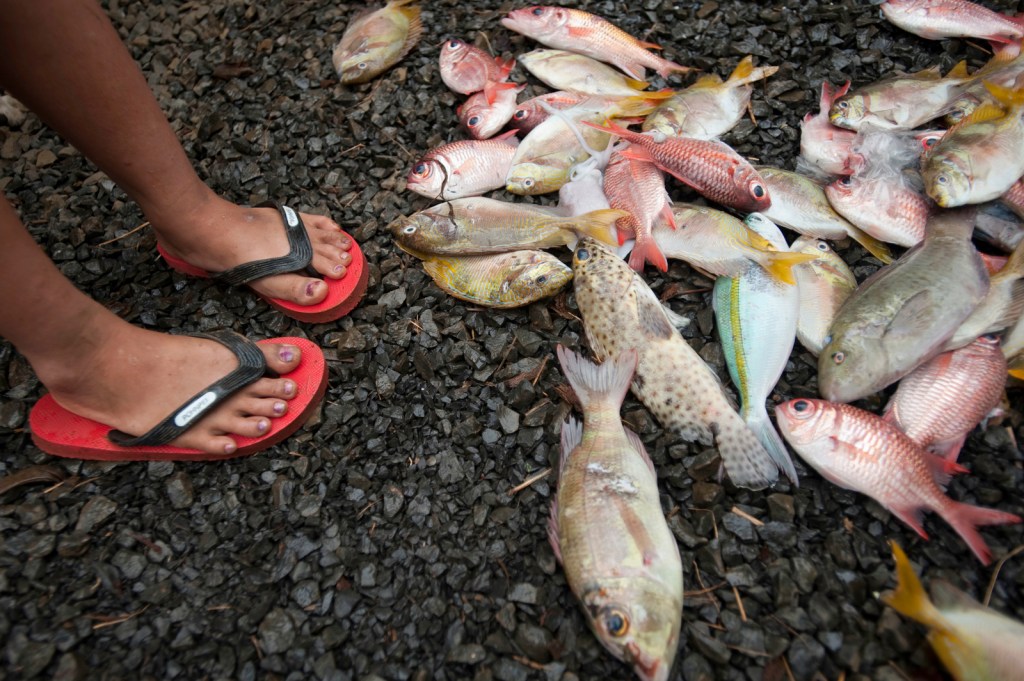“If it doesn’t get measured, it doesn’t get managed.”
If the old adage is true for business, then it’s doubly true for global fish stocks. In fact, of the more than 10,000 fisheries in the world, fewer than 440 (mostly in upper-income countries and in top-traded fish like tuna) are regularly assessed — measured — with robust scientific methods. That means the vast majority of the world’s fisheries go unmeasured and therefore unmanaged.
Why? Because traditional stock assessments — scientific measures of fish populations, current fishing pressures, and how much harvesting a fishery can support — are too expensive and resource-intensive for most fisheries and governments. The bad news is: Unmanaged fisheries are at high risk of over-fishing and collapse, damaging economies, human health and biodiversity.
“The good news is,” says Carmen Revenga, the Nature Conservancy’s Global Fisheries Lead, “there are methods to assess stocks with limited data at lower costs than traditional stock assessments. However, the complexity of choice can be challenging: how do managers choose between the hundreds of different ways to collect data, assess the status of the stock, select and implement management regulations?”
It’s that complexity that some of the world’s leading fisheries scientists and managers set out to simplify. In 2013, they launched the Data-Limited Fisheries Working Group under the auspices of the Science for Nature and People Partnership (SNAPP) and with leadership and additional funding from the Conservancy’s Global Oceans Program.
Now, two years later, the working group is field testing a new user friendly application that puts sound management and science-based sustainability within the reach and capabilities of small-scale and data-limited fisheries.
Kenya, Palau, Peru, US: Road Testing the Solution
The SNAPP Data-Limited Fisheries Working Group brought together the best minds in fisheries science to develop a comprehensive framework for guiding the decision making process of how to assess and manage data limited fisheries. The tool is a user-friendly guide to selecting context appropriate management strategies to guide fisheries towards sustainability.
It is also the only tool that considers data and ecosystem considerations as well as socioeconomics and governance realities. Right now, Conservancy and working group scientists are working with practitioners and fisheries agencies on the ground at pilot sites for the lorna drum in Peru, spiny lobsters in Kenya, coral reef finfish in Palau, and rock crab and abalone in California to refine and road test the application.
They are also working with ecolabels and certification agencies, including the Marine Stewardship Council, to explore the opportunity for using this tool as a platform to guide fisheries towards sustainability.
“Our workshop in Peru was a huge success,” said Jeremy Rude, Conservancy fisheries specialist. “We met with the Marine Institute of Peru (IMARPE), a government agency overseeing the management of Peru’s fisheries resources. Our tool showed that a practically unmanaged fishery, the lorna drum, was not as data-limited as they had thought. They were surprised to learn through our tool that many options are available to assess the health of the population and move the fishery in the direction of sustainability. Several other fisheries were quickly identified as possibilities.”
The approach is efficient, transparent, and comprehensive and can serve as the standard bearer across all fishery improvement projects. By creating such an objective and consistent approach to fishery improvements, the ability to work at larger scales increases tremendously, opening the door to better management, certification and eventually sustainability for thousands of fisheries around the world.
Why Measured Management Matters
Healthy fisheries and the marine habitats they depend on are the necessary and living foundation of healthy oceans. But right now many of the world’s fisheries are declining. The numbers tell the story: More than 90 percent of marine fisheries worldwide are overfished or fished at their biological limit.
10 percent of the global population is employed in fishery-related industries, but the World Bank still estimates that current inefficiencies in fisheries management cost the world’s economy $50 billion annually.
Clearly, there is a lot of room for improvement in the way the world manages its fisheries.
The Path to Sustainable Fisheries is Paved with Data
As consumers put more emphasis on purchasing sustainably managed fish, ecolabels and certification agencies working with retailers and fish distributors are hitting a bottleneck. The better managed fisheries are already certified or on the path to certification, but the bulk of the worlds fisheries are locked out of the market.
“The SNAPP framework is standardizing what fisheries managers have been doing informally and ad hoc for years,” said Rude. “It not only allows stakeholders to understand why certain management strategies are identified as favorable options and others were excluded, but it increases the transparency of decision-making in fisheries management. It’s opening the door for thousands of small-scale fisheries that want to gain access to new markets through ecolabels and certification.”




Wondering where that photo was taken? Interested in one of the rabbit-fish
Hi Patrick — it was taken in Micronesia (Pohnpei). Here’s the full caption from our photo archive: Members of the Paulino family (Enipein Village in Pohnpei, Federated States of Micronesia) examine their catch some of which they will sell to other members of their village community. Fishermen will often catch extra fish so that they can sell what they can’t eat to generate additional income for their families. There is growing concern among the Pohnpeian government and conservation community that the increasing commercialisation of Pohnpei’s reef fisheries is leading to unsustainable resource utilisation and a declining fish population. Life in Micronesia has been shaped by the islands’ remoteness and the rich resources of their lands and seas. Yet this dependence makes islanders especially vulnerable to environmental threats, such as rising sea levels, pollution, deforestation and unsustainable fishing. The Nature Conservancy is working with both local government and NGOs to conserve resources and meet the future needs of the population through a program known as the Micronesia Challenge. PHOTO CREDIT: © Nick Hall (His Instagram page is here https://www.instagram.com/nickhallphoto/)